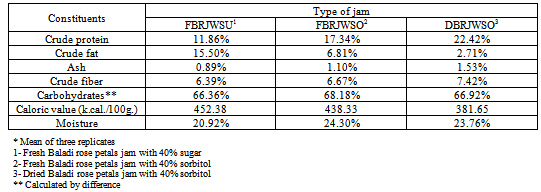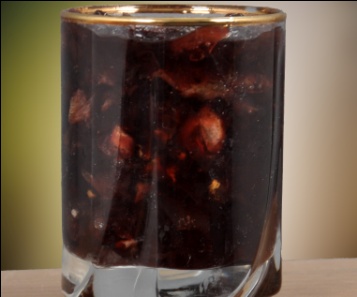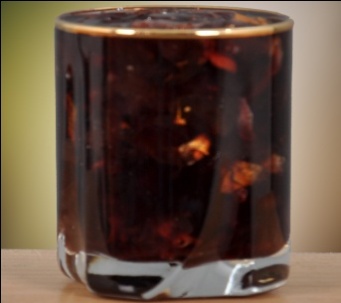Hanan M. K. E. Youssef , Rasha M. A. Mousa
Food Science & Technology Department, Faculty of Agriculture, Ain Shams University. Postal Code : 11241,Cairo,Egypt
Correspondence to: Hanan M. K. E. Youssef , Food Science & Technology Department, Faculty of Agriculture, Ain Shams University. Postal Code : 11241,Cairo,Egypt.
| Email: |  |
Copyright © 2012 Scientific & Academic Publishing. All Rights Reserved.
Abstract
Baladi rose petals are ornamental horticultural commodities of high economic value as cut flowers and flower oil raw materials used in the perfume industry. Likewise Baladi rose petals can also be used for tea, jelly and jam as a valuable healthful functional food due to their nutrients they contain. The present investigation was carried out to assess the nutritional status of low-caloric Baladi rose petals jam including the pH, total soluble solids, gross chemical composition, caloric value and mineral composition (Fe, Mn, Zn, Ca, Mg, Na, K and P). Three types of jam, namely: fresh Baladi rose petals jam with 40% sugar, fresh Baladi rose petals jam with 40% sorbitol, and dried Baladi rose petals jam with 40% sorbitol, were processed. Sensory evaluation proved that both fresh Baladi rose petals jam with 40% sugar or 40% sorbitol recorded best scores. Jam constituents ranged between 11.86%-22.42% Crude protein, 2.71%-15.50% Crude fat, 0.89%-1.53% Ash, 6.39%-7.42% Crude fiber, 66.36%-68.18% Carbohydrates, 20.92%-24.30% Moisture; and 381.65-452.38 Caloric value (k.cal./100g.).; respectively. General order of minerals abundance was K>Na>Mg>Ca. The Baladi rose petals with 40% sugar or 40% sorbitol could be recommended for the diet regimen of diabetic persons.
Keywords:
Rose Jam, Chemical Composition, Minerals, Sensory Characteristic, Sorbitol, Total Soluble Solids, Low Calories
Cite this paper:
Hanan M. K. E. Youssef , Rasha M. A. Mousa , "Nutritional Assessment of Low-Calorie Baladi Rose Petals Jam", Food and Public Health, Vol. 2 No. 6, 2012, pp. 197-201. doi: 10.5923/j.fph.20120206.03.
1. Introduction
Rose is a buch plant of the genus Rosa as well as the name of this plant produced flowers. Most species have petals between 5-15 cm in length, two-two opposite (pinnte). The compound leaves of each leaf stack consists of at least 3 to 5 to 9 or 13 children lever age leaves and leaf (stipule) is elliptical, pertulangan pinnate, edge beringgit, tapered at the tip of the petals and thorns on the stem which is close to the gorund (Ercisili, (1).The rose had always been valued for its beauty and had a long history of symbolism. Roses are ancient symbols of love and beauty (Encyclopedia > Rose, (2). Rose have many benefits, including antidepressant, antiviral, antibacterial, antiflammatory, and source of vitamin C. Rose is a horticultural commodities of high economic value as cut flowers and flower oil raw materials used in the perfume industry. Roses can also be used for tea, jelly and jam (HadjMohammadi et al., (3) ( Ercisili, (1).The gross chemical composition as well as the mineral elements composition of rose petals were reported by Ercisili (1), HadjMohammadi et al., (3), Seker and Toplu (4), and Taherpour et al. (5).On the other hand, the therapeutic properties of Baladi rose petals oil, namely: antidepressant, antiphlogistic, antispasmodic, antiviral, aphrodisiac, astringent, bactericidal, choleretic, cicatrisant, depurative, emmenagogue,haemostatic, hepatic, laxative, nervous system sedative, stomachic and a tonic for the heart, liver, stomach and uterus, were reported by Encyclopedia > Rose (2), Seker and Toplu (4), Ocksook et al. (6), Anon. (7) and Anon (8).Furthermore, the chemical composition of the essential oil of rose petals was stated by Adams (9), Babu and Kaul (10), Setzer (11), Cole et al. (12), Eason and Setzer (13), Setzer and Haber (14), Takaku et al. (15), Setza et al. (16), and Taherpour et al. (5).This investigation was designed to produce the Baladi rose petals jam, which has better nutritional value, available with low caloric value and relatively cheap and does not require any preparation efforts for production. The objective of the present investigation was to assess the gross chemical composition, caloric value, the mineral composition as well as physical characteristics and sensory quality attributes of low calorie Baladi rose petals jam.
2. Materials and Methods
2.1. Materials
The plant material was collected from shrubs growing in the Ornamental Gardens of Assiut University agricultural Farm at the flowering stage in April 2011.30 kg Baladi roses (Rosa gallica var. aegyptiaca) were collected daily during April 2011 at the early morning. The Baladi rose leaves color was pink and red. The Baladi roses were kept in baskets full of water for 1 hour at least after cutting before transport to the laboratory. The rose petals were cut and half of the roses were used fresh for jam preparation and the second half was sun dried to complete dryness on wood trays. The dried Baladi rose petals were used for jam preparation.Sugar powder and Egyption Baladi lemon were purchased from Assiut local market in April 2011. Rose flower water was procured from gourmet food stores in Assiut, in April 2011, Chemical pure Sorbitol alcohol was obtained from Assiut Commerce and Chemicals Company in April 2011.
2.2. Baladi Rose Petals Jam Preparation
2.2.1. Jam Ingredients
Control Baladi rose petals jam was prepared according to the formula presented in table (1), Youssef (17). The recommended low calorie Baladi rose petals jam was prepared using the same formula except for replacing the 40%powdered sugar with 40% sorbitol.| Table (1). Baladi rose petals jam formula |
| | Ingredients | Amount (g.) | | Rose leaves | 1000 | | Powdered sugar | 400 | | Water | 1000 | | Lemon (2 lemons) | 1 tablespoon freshly squeezed lemon juice | | Rose flower water | 1 tablespoon |
|
|
2.2.2. Preparation of Baladi Rose Petals Jam
Fresh Baladi rose petals washed with water were placed in a bowl sprinkled with the sugar over them to make sure that all leaves were coated. Thereafter, they were allowed to remain overnight in a cool spot that is not too dry and not too humid (e.g. the refrigerator at 4°C).A saucepan was got and poured in the remaining sugar, water and lemon juice. The contents were dissolved over a low heat. The rose petals were stirred into the mixture and were allowed to simmer 20 minutes. Then they were brought to a boil and continued to boil for 5 minutes until the mixture thickened (cooking and stiring were continued until the jam reached 105°C or until a spoonful dropped onto a cold plate jelled and hold its shape. The jam was poured into a clean, warmed jar and the cover and the label were added (Youssef, (17).Dried Baladi rose petals jam were prepared applying the same method except that 40% powder sugar was replaced by 40% sorbitol.
2.3. Methods
2.3.1. pH and Total Soluble Solids of Jam
The pH of Baladi rose petals jam was evaluated using pH-Meter-18. AQUA Lytic NPC Electrode Great Nr. 1598-HI 1333. While, the total soluble solids were determined by ATAGO-073828-Hand Refrcatometer.
2.3.2. Sensory Evaluation of Jam
Sensory evaluation for the color, texture, taste, odor and overall acceptability were done in order to determine consumer acceptability. A numerical hedonic scale ranging from 1 to 10 (1 is very bad and 10 for excellent) was used for sensory evaluation (Larmond,(18). Ten experienced judges participated in the test.
2.3.3. Proximate Chemical Composition of Jam
Moisture, protein, crude fibers and ash contents were determined according to the method described in the AOAC (19). Fat content was determined as the ether extract according to AOCS (20). Total carbohydrates were calculated by difference according to Pellet and Sossy (21). All determinations were performed in triplicates and the means were reported. The caloric value was calculated using 4 k.cal/g of protein, 4 k.cal/g of carbohydrate and 9 k.cal/. of fat according to Livesy (22).
2.3.4. Determination of Mineral Contents of Jam
The minerals contents, i.e. (sodium, potassium, calcium, iron, copper, zinc, manganese, and phosphorus) of Baladi rose petals jam were determined according to the methods described in AOAC (19). The samples were acid digested using a nitric acid and perchloric acid mixture (HNO3, HCLO4, 2:1 v/v). The amounts of iron, copper, zinc, and manganese in the digested sample were determined using a GBC Atomic Absorption 906 A as described in AOAC (19). Sodium and potassium were determined by Flame photometer 410. Calcium and magnesium were determined using Double Beam Atomic Absorption. Phosphorus was determined according to the method described in A.O.A.C. (19).
3. Results and Discussion
3.1. pH and Total Soluble Solids of Jam
The mean values of pH and total soluble solids of Baladi rose petals jam are presented in Table (2). The data revealed that the pH values ranged from 4.8 to 6.3 in the three studied rose petals jams with an intermediate pH value (5.4) recorded for the fresh Baladi rose petals jam with 40% sugar. Such data are in good agreement with Ercisli (1), and Seker and Toplu (4). Likewise, the total soluble solids ranged from 73% to 74% in the three studied rose petals jam with an intermediate total soluble solids value (69%) recorded for the fresh Baladi rose petals jam with 40% sorbitol.Table (2). Mean values of pH and total soluble solids (T.S.S.) of Baladi rose petals jam
 |
| |
|
Table (3). Sensory characteristics of Baladi rose petals jam*
 |
| |
|
Table (4). Gross chemical composition and caloric value of Baladi rose petals jam (on dry weight basis)*
 |
| |
|
3.2. Sensory Characteristics of Jam
The sensory characteristics of the three studied Baladi rose petals jam are outlined in Table (3) and photo 1-3. The data revealed that both fresh Baladi rose petals jam with 40% sugar and fresh Baladi rose petals jam with 40% sorbitol recorded the best sensory characteristics. Therefore, both jams could be recommended to be produced as Baladi rose petals jam with good quality acceptable sensory quality attributes for the consumers. Likewise, on the basis of such results further analysis of gross chemical composition and mineral composition of the three studied Baladi rose petals jam were evaluated. | Photo 1. Dry Baladi rose petals Jam with 40% sorbitol |
 | Photo 2. Fresh Baladi rose petals jam with 40% sorbitol |
 | Photo 3. Fresh Baladi rose petals jam with 40% sugar |
3.3. Gross Chemical Composition of Jam
The mean value of gross chemical composition and caloric value of Baladi rose petals jam are given in Table (4). The data revealed that the Baladi rose petals jam constituents ranged between 11.86%-22.42%, 2.71%-15.50%, 0.89%-1.53%, 6.39-7.42%, 66.36%-68.18%, and 20.92%-24.30% for crude protein, crude fat, ash, crude fiber, carbohydrate; and moisture; respectively.While, the caloric value of Baladi rose petals jam ranged between 381.65-452.38 k.cal/100 g. calculated on dry weight basis, with an intermediate value (438.33 k.cal/100 g.) for fresh Baladi rose petals jam with 40% sorbitol. However, the dried Baladi rose petals jam with 40% sorbitol recorded the least caloric value (381.65 k.cal/100 g.) on dry weight basis. The data of the gross chemical composition of the Baladi rose petals jam reported in the present investigation are in good accordance with that previously reported by Ercisli (1), HadjMohammadi et al. (3), and Seker and Toplu (4).
3.4. Minerals Composition of Jam
The mean values of minerals composition of Baladi rose petals jam are outlined in Table (5). The data revealed that all the three studied rose petals jams had high levels of Ca, Mg, Na and K. The general order of abundance of the minerals was K>Na>Mg>Ca. meanwhile, Fe, Zn, Mn and P recorded relatively the least levels in descending order. Such data coincide with Ercisili (1), and Seker and Toplu (4) findings.In conclusion, the three studied Baladi rose petals jams proved to be nutritious functional and healthful foods. Moreover, they could be recommended for calorie reduced diet for the diet regimen of diabetic persons.
References
| [1] | Ercisili, S. (2007). Chemical of fruit sin some rose (Rosa spp.) species. Food Chemistry, Volume 104, Issue 4, 1379-1384. |
| [2] | Encyclopedia > Rose (2007).http://www.nationmaster.com/encyclopedia |
| [3] | HadjMohammadi, M.R., Alfifi, A.A., and Rezaee, M.B. (2006). Chemical composition of leaf, flower and fruit oils of vitex pseudo – megundo (Hausskn.) Hand- Mzt. From IRAN Copyright Allured Publishing Corporation. |
| [4] | Seker, M. and Toplu, C. (2010). Determination and comparison of chemical characteristics of Arbutus unedo L. and Arabutus andrachane L. (Family Ericaceae) fruits. Journal of Medicinal Food. Volume 13. Issue 4: 1013-1018. |
| [5] | Taherpour, A.A., Maroofi, H., Changizi, M., Shoushtari, R.V., Larijani, K. and Kazempour, A. (2011). Chemical composition of essential oil and calculation of the biophysiochemical coefficients of the components of the hymenocrater Iongiflorus Benth. of Iran. Nature Science. Volume 3, No. 2; 104-108. |
| [6] | Ocksook, Y., Jovel, E.M., Neikl Towers, G.H., Wahbe, T.R. and Cho, D. (2007). Antioxidant and antimicrobial activities of native Rosa sp. from British Columbia, Canada. International J. of Food Sciences and Nutrition. Vol. 58, No. 3. 178-189. |
| [7] | Anon. (2009). www.foodnet.cgiarorg/market/Uganda/reports/. Roses. PDF FoodNet Uganda. |
| [8] | Anon. (2010). Rose and Rose Legend: Therapeutical applications, history and new findings. Herbalist of MDidea Extracts Professional. 20th Dec. |
| [9] | Adams, R.P. (1995). Identification of essential oil components by gas chromatography/mass-spectroscopy. Allured Publishing Corporation, Illinois. |
| [10] | Babu, K.G.D. and Kaul, V.K. (2005). Variation in essential oil composition of rose-scented geranium (Pelargonium sp.) distilled by different distillation techniques. Flavour and Fragrance Journal. 20, 222-231. |
| [11] | Setzer , W.N. (2006). Chemical composition of the bark essential oils of Croton monterverdensis and corton niveus from Monteverde, Costa Rica. Natural Product Communications, 1, 567-572. |
| [12] | Cole, R.A., Haber, W.A. and Setzer, W.N. (2007). Chemical composition of essential oils of seven species of Eugenia from Monteverde. Costa Rica. Biochemical Systematics and Ecology. 35, 877-886. |
| [13] | Eason, H.M. and Setzer, W.N. (2007). Bark essential oil composition of Cedrela tonduzii C. DC. (Meliaceae) from Monteverde, Costa Rica. Records of Natural Products. 1, 24-27. |
| [14] | Setzer, W.N. and Haber, W.A. (2007). Leaf essential oil composition of five species of Beilschmiedia from Monteverde, Costa Rica. Natural Products Communications, 2, 79-83. |
| [15] | Takaku, S., Haber, W.A., and Setzer, W.N. (2007). Leaf essential oil composition of 10 species of Ocotea (Lauraceae) from Monteverde. Costa Rica. Biochemical Systematics and Ecology. 35, 525-532. |
| [16] | Setzer, W.N., Park, G., Agius, B.R., Stokes, S.I., Walker, T.M. and Haber, W.A. (2008). Chemical composition, and biological activities of leaf essential oils of twelve species of Piper from Monteverde. Costa Rica. Molecules, 13. |
| [17] | Youssef, M.K.E. (2011). Personal communications, Food Science and Technology Department, Faculty of Agriculture, Assiut University, Assiut, A.R. Egypt. |
| [18] | Larmond, E. (1977). Laboratory Methods for Sensory Evaluation of Food. Canadian Government Publishing Center. Ottawa. |
| [19] | AOAC (1997). Official Methods of Analysis. 16th Ed., Association of Official Analytical Chemists.Arlington-Virginia, USA. |
| [20] | AOCS (1994). Official Methods of American Oil Chemists Society. Champaign. Illinois. USA. |
| [21] | Pellet, P.I. and Sossy, S. (1970). Food Composition Tables for Use in the Middle East. American University of Beirut. Beirut – Lebanon. |
| [22] | Livesy, G. (1995). Metabolizable energy of macronutrients. Am. J. Clin. Nutr. 62 (Suppl.) – 11355-11425. |




 Abstract
Abstract Reference
Reference Full-Text PDF
Full-Text PDF Full-Text HTML
Full-Text HTML

